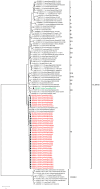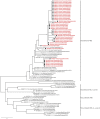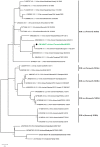Genetic Diversity of Newcastle Disease Virus Involved in the 2021 Outbreaks in Backyard Poultry Farms in Tanzania
- PMID: 37505881
- PMCID: PMC10385779
- DOI: 10.3390/vetsci10070477
Genetic Diversity of Newcastle Disease Virus Involved in the 2021 Outbreaks in Backyard Poultry Farms in Tanzania
Abstract
Newcastle disease virus is a significant avian pathogen with the potential to decimate poultry populations all over the world and cause enormous economic losses. Distinct NDV genotypes are currently causing outbreaks worldwide. Due to the high genetic diversity of NDV, virulent strains that may result in a lack of vaccine protection are more likely to emerge and ultimately cause larger epidemics with massive economic losses. Thus, a more comprehensive understanding of the circulating NDV genotypes is critical to reduce Newcastle disease (ND) burden. In this study, NDV strains were isolated and characterized from backyard poultry farms from Tanzania, East Africa in 2021. Reverse-transcription polymerase chain reaction (RT-PCR) based on fusion (F) gene amplification was conducted on 79 cloacal or tracheal swabs collected from chickens during a suspected ND outbreak. Our results revealed that 50 samples out 79 (50/79; 63.3%) were NDV-positive. Sequencing and phylogenetic analyses of the selected NDV isolates showed that 39 isolates belonged to subgenotype VII.2 and only one isolate belonged to subgenotype XIII.1.1. Nucleotide sequences of the NDV F genes from Tanzania were closely related to recent NDV isolates circulating in southern Africa, suggesting that subgenotype VII.2 is the predominant subgenotype throughout Tanzania and southern Africa. Our data confirm the circulation of two NDV subgenotypes in Tanzania, providing important information to design genotype-matched vaccines and to aid ND surveillance. Furthermore, these results highlight the possibility of the spread and emergence of new NDV subgenotypes with the potential of causing future ND epizootics.
Keywords: East Africa; genotypes; newcastle disease virus (NDV); phylogenetic analyses; poultry; tanzania.
Conflict of interest statement
The authors declare no conflict of interest.
Figures






Similar articles
-
NDV subgenotype VII(L) is currently circulating in commercial broiler farms of Iran, 2017-2018.Trop Anim Health Prod. 2019 Jun;51(5):1247-1252. doi: 10.1007/s11250-019-01817-1. Epub 2019 Jan 28. Trop Anim Health Prod. 2019. PMID: 30689157
-
Molecular characterization of Newcastle disease virus obtained from Mawenzi live bird market in Morogoro, Tanzania in 2020-2021.Braz J Microbiol. 2023 Dec;54(4):3265-3273. doi: 10.1007/s42770-023-01159-z. Epub 2023 Nov 1. Braz J Microbiol. 2023. PMID: 37907827 Free PMC article.
-
Molecular Characterization of Newcastle Disease Viruses Isolated from Chickens in Tanzania and Ghana.Viruses. 2020 Aug 20;12(9):916. doi: 10.3390/v12090916. Viruses. 2020. PMID: 32825492 Free PMC article.
-
Immune responses of poultry to Newcastle disease virus.Dev Comp Immunol. 2013 Nov;41(3):447-53. doi: 10.1016/j.dci.2013.04.012. Epub 2013 Apr 25. Dev Comp Immunol. 2013. PMID: 23623955 Review.
-
Newcastle disease: evolution of genotypes and the related diagnostic challenges.Infect Genet Evol. 2010 Jan;10(1):26-35. doi: 10.1016/j.meegid.2009.09.012. Epub 2009 Sep 30. Infect Genet Evol. 2010. PMID: 19800028 Review.
Cited by
-
Exploring the genetic basis of Newcastle disease virus in chickens: a comprehensive review.Front Immunol. 2025 Jun 27;16:1614794. doi: 10.3389/fimmu.2025.1614794. eCollection 2025. Front Immunol. 2025. PMID: 40655137 Free PMC article. Review.
-
Development of a genotype-matched Newcastle disease DNA vaccine candidate adjuvanted with IL-28b for the control of targeted velogenic strains of Newcastle disease virus in Africa.Vet Res Commun. 2024 Nov 25;49(1):33. doi: 10.1007/s11259-024-10590-y. Vet Res Commun. 2024. PMID: 39585481 Free PMC article.
-
Newcastle disease virus genotype VII.1.1 identified from backyard chickens with low antibody titer: Jimma Zone, Southwest Ethiopia.BMC Vet Res. 2025 Jan 16;21(1):23. doi: 10.1186/s12917-025-04474-9. BMC Vet Res. 2025. PMID: 39819336 Free PMC article.
-
Evaluating the impact of avian paramyxovirus type 1 infection in poultry at live bird markets in Nigeria: defining hurdles to sustainable agriculture.BMC Vet Res. 2025 Feb 12;21(1):62. doi: 10.1186/s12917-025-04508-2. BMC Vet Res. 2025. PMID: 39939962 Free PMC article.
-
Current Status of Poultry Recombinant Virus Vector Vaccine Development.Vaccines (Basel). 2024 Jun 6;12(6):630. doi: 10.3390/vaccines12060630. Vaccines (Basel). 2024. PMID: 38932359 Free PMC article. Review.
References
-
- ICTV: International Committee on Taxonomy of Viruses Virus Taxonomy. 2019. [(accessed on 11 February 2021)]. Available online: https://talk.ictvonline.org/taxonomy/
-
- Hewajuli D.A., Dharmayanti N.L.P.I. Patogenitas Virus Newcastle Disease Pada Ayam. Wartazoa. 2011;21:72–80.
-
- Lamb R.A., Parks G.D. Paramyxoviridae: The Viruses and Their Replication. Lippincott, Williams, and Wilkins; Philadelphia, PA, USA: 2007. pp. 1449–1496.
Grants and funding
LinkOut - more resources
Full Text Sources

